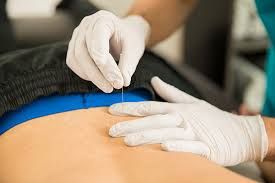Dry needling can be an effective treatment tool to decrease pain and tightness in muscles. The advantage is that it gets deeper into the muscle layer than massage alone. As an example, we can target your Multifidis muscle around your lumbar spine, which if dysfunctional may not be supporting your lumbar spine, but compressing the joints and discs. It may be a reason for your lack of movement (bending forwards or backwards), tightness in your large outer back muscles, or may be contributing to your lower back, SIJ or leg pain. This muscle may be as deep at 6cm down, and obviously, our hands cannot reach this area from above.
Some FAQ are answered below
- What is Dry Needling? Dry Needling involves multiple advances of an acupuncture-type needle into the ‘trigger point’ of the muscle. The aim is to achieve a twitch in the muscle, which is associated with reduced muscle tension and pain. What will I experience? The needles used are very thin, and you may or may not feel the needle enter your skin. If the muscle being needled is tight and/or sensitive you will feel a cramping or twitch sensation. This is very short-lasting, and patients soon learn to recognise this sensation as therapeutic as it is followed by a feeling of pain relief and muscle relaxation.
- Are there any side effects? The most common side effect is temporary muscle soreness after the treatment. This typically lasts for a day or two, and your clinician will instruct you on how to minimise this. There are other less common side effects such as bruising. If you have any questions about side effects, please discuss this with your clinician.
- How does Dry Needling help? Dry Needling helps to reduce pressure on the nerve by releasing muscle shortening. It is now well researched that the ‘twitch’ response in the muscle during dry needling is associated with the muscle relaxing and stopping the pull on adjacent areas.
- How often will I need treatment? Treatments are typically once a week, to allow enough recovery time between treatment sessions. However, this can vary. The number of treatments you will require will depend on many things, such as:
- How long you have had your problem
- The extent of your problem
- How long it takes to address the contributing factors
- How quickly your body can heal
- Are there any contraindications to Dry Needling? Prior to treatment please inform your clinician if you are pregnant, or have any of the following:
- Metal allergies
- Implants
- Axillary or inguinal node dissection
- Joint replacements
- Needle phobia
If you are interested in this technique or have any further questions contact us today on 55277092 or book online

